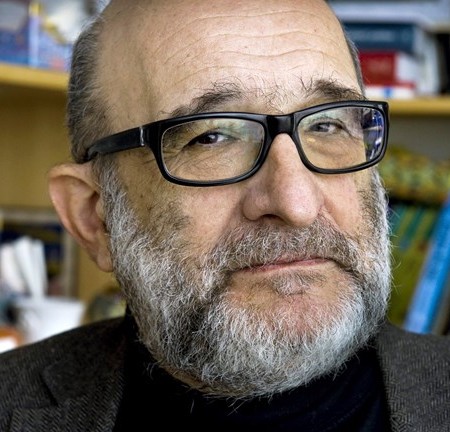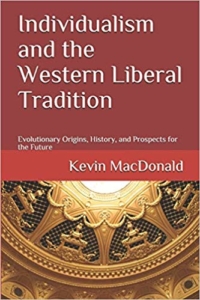Go to Part 1
Go to Part 2
Go to Part 3
Go to Part 4
Psychological Mechanisms for a White Renaissance
In general, individualists are less ethnocentric than others, but this does not imply that they are incapable of ethnocentrism. It makes sense a priori to suppose that natural selection would act to make humans—even individualistic Whites—at least somewhat ethnocentric. Frank Salter presents a powerful case for the adaptiveness of ethnocentrism.[1] Different human ethnic groups and races have been separated for thousands of years, and during this period they have evolved some genetic distinctiveness. This genetic distinctiveness constitutes a storehouse of genetic interest. In other words, people have an interest in their ethnic group in exactly the same way that parents have a genetic interest in their children.
In raising their children, parents ensure that their unique genes are passed on to the next generation. In defending their ethnic interests, people are doing the same thing—ensuring that the genetic uniqueness of their ethnic group is passed on to the next generation. When parents of a particular ethnicity succeed in rearing their children, their ethnic group also benefits because the genetic uniqueness of their ethnic group is perpetuated as part of their children’s genetic inheritance. Moreover, when an ethnic group succeeds in defending its interests, individual members of the ethnic group also benefit because the genetic uniqueness that they share with other members of the ethnic group is passed on. This is the case even for people who don’t have children: A person succeeds genetically when his ethnic group as a whole prospers.
Even a cursory look at the historical record shows that conflict between biologically related tribal groups has been common throughout history. Cooperative defense by tribal peoples is universal and ancient and it is bound to have boosted the genetic fitness of those who acted to further the interests of their group. Under such circumstances it would be odd indeed if natural selection did not mold the human mind to be predisposed to ethnocentrism. Of course, this fact does not tell us what psychological mechanisms actually evolved to promote ethnocentrism or how these mechanisms can be controlled by inhibitory mechanisms located in the prefrontal cortex. For that, we will have to turn to the empirical research.
My review of the literature concluded that there are universal mechanisms underlying ethnocentrism.[2]
- Mechanisms of genetic similarity: People preferentially assort with genetically similar others. Friends, spouses, and the other people we make alliances with are more like us than people selected at random; other things being equal, this enhances the benefits of such relationships and lessens the risks.[3] This is the most likely explanation for implicit Whiteness.
- As noted above, there is good evidence that social identity processes are a biological adaptation important for group defense. But since they don’t necessarily respond to genetic differences between groups, they are not really of use in ethnic defenseunless the groups are already constituted on an ethnic basis, as in traditional tribal societies.
- Groups composed of sports fans and the like can trigger social identity processes, but they do not result in the deep emotions that are aroused in ethnic, religious, and patriotic groups. It is not at all uncommon for people to make the ultimate sacrifice on behalf of these groups. The best explanation for this is that humans have a natural tendency to classify themselves into ingroups and outgroups on the basis of these categories so that they tend to have stronger allegiance to these groups than, say, their stamp collecting club. Race and ethnicity have all the features of an evolved module. For example, processing of racialand ethnic differences is rapid, unconscious, and automatic[4]—all characteristics of implicit processing and hallmarks of evolved modules.
In any case, whatever the strength of the mechanisms underlying ethnocentrism, given the tendencies of Whites toward individualism in the context of the present cultural environment of the West that vilifies White ethnocentrism, these mechanisms have thus far proved insufficient to provide for ethnic defense of Whites. However, the current culture also contains facets that will in fact increase White ethnocentrism.
Being Aware of Impending Minority Status Triggers White Ethnocentrism
The foregoing has discussed why achieving widespread acceptance by Whites of an explicit culture of White identity and interests is an uphill struggle. However, there are also mechanisms that are likely to create an increased sense of White identity and White interests in the years ahead. The fundamental reason for this is the demographic transformation resulting from massive immigration of non-Whites into countries that were either homogeneously White or, like the United States (ninety percent White in 1960), had a politically dominant White majority. This transformation, in which it is obvious that White political power is declining as Whites head toward minority status, would by itself trigger defensive mechanisms of implicit Whiteness and behavior such as White flight discussed above.
Individualists are less naturally ethnocentric, and the left has created a culture that encourages Whites to inhibit expressions of ethnocentrism while encouraging non-Whites to be ethnocentric. Because the media is dominated by the left and because even the conservative media is terrified of appearing to advocate White interests, explicit messages that would encourage Whites to become angry and fearful about their future as a minority are rare. Indeed, the media rarely, if ever, mentions that Whites are well on their way to becoming a minority. And this for good reason: Whites in the United States and in Canada who are given explicit demographic projections of a time when Whites are no longer a majority tend to feel angry and fearful. They are also more likely to identify as Whites and have sympathy for other Whites.[5]
In other words, while I have emphasized the ability of the higher brain centers to inhibit ethnocentrism, explicit messages indicating that one’s racial group is threatened are able to trigger ethnocentrism. This is especially important because many Whites live far from the areas undergoing the demographic shifts. Their day-to-day life of living in an essentially White environment hasn’t changed while population centers such as Los Angeles, Sydney, Toronto, and London have changed beyond all recognition from what they were 50 years ago. An obvious inference is that pro-White activists should appeal to Whites’ higher brain centers with explicit messages emphasizing these transformations.
Expressions of Anti-White Hatred Promote White Ethnocentrism
Another force that will make Whites more willing to coalesce into cohesive groups is the strident anti-White rhetoric that is now common in the elite media and academic culture throughout the West. There are many examples of this. It’s common now for the left to conceptualize American history as nothing more than dispossessing the Indians and enslaving Africans, Jim Crow laws in the South, etc., with the result that American history is being deconstructed from an anti-White perspective—Howard Zinn’s A People’s History of the United States, 1492–Present is the classic text.[6] American historical figures are being delegitimized, their statues removed, etc.
Recently the New York Times hired Sarah Jeong, an Asian woman with a history of anti-White tweets, the New York Times’ Michelle Goldberg rejoiced that Whites are being replaced in Georgia, a Princeton classics professor advocated shutting off White men from publishing in the field, and CNN’s Don Lemon stated that White males are America’s biggest terror threat.[7]
It’s obvious that in a post-Obama America the anti-white zeitgeist is out of pandora’s box. … Due to unprecedented immigration and fatalist progressive experiments, there is no country where anti-white cultural currents are not rising. It wasn’t supposed to be this way, weakness, wealth transfers, preferential treatment, open borders and accommodation were supposed to invite warm feelings, equal outcomes and racial blindness. …
By the 1990s the entire constellation of Christian morality and civic responsibility in the public space had been secularized and compressed into a singular mandate. Millennials were taught from childhood that the highest moral good was serving the self-esteem of non-whites. In prior ages virtues such as courage, modesty, chivalry, valor and faith were ways young adults were encouraged to distinguish themselves but for Millennials it was an adeptness and willingness to navigate the mercurial minefield of knowing when and how to serve the self-esteem of non-whites that mattered.
Over the past thirty years conservatives were busy building an entire culture around anti-socialism while the Left was busy pushing its cultural trojan horse to unleash a whole different kind of plague. Maybe deep down many conservatives knew the anti-white dam would burst but they were too cowardly to confront it.[8]
Too cowardly indeed—quite like the professors unwilling to discuss Jewish influence on Mideast policy.
The following discusses several evolved mechanisms acting at the implicit, unconscious level that could act as a countervailing force to this culture of the left.
Social Identity Processes
At the outset of this chapter I reviewed research on social identity processes indicating that identification with an ingroup is increased in the presence of group competition—part of the argument for why social identity processes are an evolved universal. Because the left has adopted a program of encouraging identity politics among its racial, religious, and gender non-conformist constituencies, the result is that boundaries between groups have become clearer, thus triggering social identity mechanisms of positive bias toward the ingroup and negative bias toward outgroups.
As noted above, an awareness of impending minority status and the ubiquity of anti-White rhetoric are processed by the higher brain centers. However, the result is that Whites feel increasingly threatened in the multicultural West. This feeling of being under threat feeds into our evolved psychology of social identity. It is thus predicted that Whites in America and throughout the West will coalesce into a cohesive group based on these processes.
White people in the U.S. are coalescing in the Republican Party, and implicit White identities and associations continue to be common. However, explicit White identities remain uncommon, a testament to White individualism and relative lack of ethnocentrism, likely dovetailing with the effects of the media, the educational system, threats of ostracism, etc. According to a 2019 Pew Research survey, Whites remain by far the least likely racial group to state that race is extremely important (5 percent) or very important (10 percent) to their identity, with Whites under age 30 least likely to say so.[9] However, between 2017 and 2019 there was an increase among Republicans (the vast majority of whom are White) who agree that “if America is too open to the other people of the world, we risk losing our identity as a nation (from 48 percent to 57 percent),” with men, older people, and the less educated more likely to express this attitude.
Even more surprising is the sudden upsurge in such sentiments: “since September [2018], the share of Republicans who say America risks losing its identity if it is too open has increased 13 percentage points, while the share who view the nation’s openness to others as essential has declined 10 points.”[10] At least some of this phenomenon is likely explained by President Trump’s rhetoric on immigration which has placed the issue front and center in American politics and resulted in a torrent of abuse from the left.
Of course, these results are likely conservative estimates due to Whites not wanting to provide such opinions to a pollster given that such attitudes are proscribed by elites in the media, political culture, and educational system.
It’s therefore of interest that data from the same poll indicated that a substantial percentage of White Americans (61 percent) have a sense of shared fate with other White people, and such attitudes are actually more common among younger adults (age 30 or less) compared to older Whites (age > 50), and they are more common among highly educated Whites.[11] Attitudes of shared fate are an indirect measure of White identity and are likely more accurate than asking direct questions about explicit White identity or wanting more diversity because such attitudes have not been explicitly condemned by the mass media and educational system. A sense of shared fate is a strong marker of ingroup identity; at the extreme, a sense of shared fate has been linked to martyrdom and other forms of self-sacrificing behavior on behalf of the group.[12] As Ben Franklin reportedly stated at the signing of the Declaration of Independence, “we must indeed all hang together, or most assuredly we will all hang separately.”
Chapters 3–5 of my book Separation and Its Discontents developed the argument that group competition has been central to the main historical examples of anti-Semitism: the development of institutionalized anti-Semitism in the Roman Empire in the fourth century, the Iberian inquisitions, and the phenomenon of National Socialist anti-Semitism in the period 1933–1945 in Germany.[13] The common denominator of these movements is that they involved a powerful sense of group cohesion in opposition to Judaism, and I argue that each of these movements may be profitably analyzed as a reaction to the presence of Judaism as a highly successful group evolutionary strategy. Based on the social identity research discussed above, powerful group strategies are expected to beget opposing group strategies that in many ways have provided a mirror image of Jewish groups which they combat—socialization for ingroup identity, punishment for defectors, feelings of ingroup superiority and outgroup inferiority, and a sense of shared fate.
What this means in the present context is that as Whites see their power diminishing and notice that hatred toward them and their history is increasingly expressed in mainstream media outlets and in the actions of activists, they will increasingly identify as Whites and develop into a much more cohesive group opposed to the forces arrayed against them. Historically, this has often ended in violent conflict between groups.
The Extremism of Scandinavian Culture: Egalitarianism, Trust, Conformity and Consensus Decision Making
It seems appropriate to conclude a chapter on the psychology of moral communities by discussing the extremism of Scandinavian political culture. In Chapter 1 it was argued that the Scandinavian countries are on the extreme end of the northwest-southeast genetic cline, with higher levels of northern hunter-gatherer-derived genes than other parts of Western Europe. Chapter 3 described these hunter-gatherer cultures as reflecting egalitarian individualism, and Chapter 4 described the Scandinavian family patterns as extreme within Western Europe.
Although all Western European-derived societies are undergoing replacement-level, non-White migration, there can be little doubt that Scandinavia and especially Sweden, are extreme in welcoming replacement of their peoples and cultures. As elsewhere in the West, a major role in these transformations has been played by Jewish activists and Jewish media ownership,[14] but Scandinavians seem particularly favorable to these transformations. Indeed, Noah Carl, analyzing 2015 survey data from the European Union, found that Swedes were the least ethnocentric group as measured by items such as approval of children having a love relationship with various ethnic groups, sexual minorities, and disabled people.[15] Respondents from the U.K. and the Netherlands were also highly tolerant, with Eastern European countries on the low end, data consistent with northwestern Europeans being the most tolerant.
The reputation-based moral communities of Scandinavia have been strongly egalitarian. The “Jante Laws” of Scandinavia are paradigmatic: 1. Don’t think you are anything; 2. Don’t think you are as good as us. 3. Don’t think you are smarter than us. 4. Don’t fancy yourself better than us. 5. Don’t think you know more than us. 6. Don’t think you are greater than us. 7. Don’t think you are good for anything. 8. Don’t laugh at us. 9. Don’t think that anyone cares about you. 10. Don’t think you can teach us anything.[16] In short, no one must rise above the rest. Such egalitarianism is typical of hunter-gatherer groups around the world[17] and is antithetical to the aristocratic ideal of the Indo-Europeans.
Extreme egalitarianism results in high levels of conformism and social anxiety. Individuals fear social ostracism for violating egalitarian norms and standing out from the crowd—a phenomenon that has played a major role in creating a public consensus in favor of mass migration and multiculturalism. Decisions are by consensus, implying that individuals are loathe to stand out from the group. In Sweden especially there is no public debate on the costs and benefits of immigration; sceptics typically remain silent for fear of shunning and disapproval.
Reflecting this pattern, contemporary Scandinavian society in general has a history of relatively small income and social class differences, including the absence of serfdom during the Middle Ages (see Chapter 4). A recent anthropological study of hunter-gatherers found that economic inequality approximated that of modern Denmark.[18] Chapter 4 discusses the individualism of Scandinavian family patterns, including relatively egalitarian relationships between spouses—extreme even within the Western European context.
Reputation-based moral communities thus lead to groupthink as individuals trust one another to have honest opinions, and individuals who deviate from group norms are shunned. A Swedish attorney commenting on a legal case where an innocent person was convicted of a crime, noted that many people were involved in the decision and all agreed with what turned out to be an unjust verdict:
When the same people participated in all or most of [the decision], a groupthink developed. … Strong trust between people is often described as one of Sweden’s great assets [but] it cannot replace a critical approach to serious allegations, even when they are self-accusations [i.e., a false confession by the accused].[19]
Strong social trust is indeed a great asset of Sweden and other countries with a significant Nordic population, leading to societies based on individual merit (a facet of reputation) and low levels of corruption. However, as in the above example, it can lead to groupthink as individuals who stand out or dissent from group norms in any way are ostracized—a facet of the Jante Laws (and the Tall Poppy syndrome of New Zealand; see Chapter 8): it’s not only excellence that is punished, but any deviation from group norms, including opinions shared by group members.
Egalitarian groups thus make decisions by consensus, not in a top-down, authoritarian manner. Once there is a decision-by-consensus, dissenters are seen as willfully ignorant or obstinate, and they lose status within the group.
Strong tendencies toward egalitarianism can thus easily lead to powerful social controls, either formal or informal, on behavior which are designed to ensure that individuals do not deviate from consensus attitudes, as noted in Puritan-derived cultures which became dominant in England and had a strong influence on the United States (Chapter 6). Thus, even though Scandinavian cultures have been described as the most individualistic in terms of family functioning (Chapter 4), it is not surprising that these cultures may exert strong controls on individual behavior to ensure conformity to the norms of a moral community.
Both egalitarianism and socially enforced norms (conceptualized in moral terms) thus typify these cultures. Sweden appears to be extreme in these tendencies. Whereas Chapter 3 discussed Sweden’s egalitarianism, here I describe the intense social controls that have virtually banned discussion of the negative aspects of immigration and multiculturalism, support for which has become a consensus among the Swedish elite.
Sweden has declared itself a “humanitarian superpower”— a superpower whose ideology is that no sacrifice by the Swedes on behalf of Third World migrants is considered too great. Official policy is that Swedes should make sacrifices to ensure sufficient housing for the continuous flow of immigrants, including repurposing churches (while mosques are being built). The government buys virtually any standing structure to be turned into immigrant housing, and there are proposals to confiscate vacation homes “for the greater good.” Meanwhile, Swedes have a lower priority for housing than immigrants, and thousands can’t find an apartment, a situation that is particularly difficult for young people, especially those wishing to start a family. Leading politicians openly say that Sweden does not belong to the Swedes, and that Swedes and Swedish culture are bland or that Sweden does not have a culture. [20]
This phenomenon is a violation of the general finding that people are less willing to contribute to public goods (e.g., public housing, health care) to people who don’t look like themselves[21] and again indicates very low ethnocentrism. Thus, the European societies that inaugurated national health care programs did so when they were racially homogeneous. Besides a long history of self-reliance as fundamental to Americans’ self-concept, a likely reason universal health care has been so slow in coming in the U.S. is its historically large Black population, and in recent decades the post-1965 multicultural tsunami.[22]
A critical aspect of the success of Swedish multiculturalism is that Swedes are terrified to violate the moral consensus surrounding migration for fear of ostracism and loss of job. They are engaging in groupthink that demands allegiance to a moral community as defined by the media and the political culture. In effect, considering the genetic distances involved, this is an extreme form of what evolutionists term “altruistic punishment”—willingness to punish one’s own people and sacrifice them on the altar of a moral ideal for fear of violating violate the norms of a moral community (Chapter 3, with further examples in Chapter 6).
Journalist Ingrid Carlqvist comments on the enforced silence on any criticism of multiculturalism, particularly in the above-ground media. Violating the silence is met with moral outrage intended to produce shunning and ostracism—in other words, there is a socially mandated groupthink where people are terrified at the thought of having dissenting opinions:
The situation in Sweden is far worse than in Denmark [which, as noted in Chapter 1 is quite different from Sweden genetically]. In Sweden nobody talks about immigration problems, the death of the multiculti project or the Islamisation/Arabisation of Europe. If you do, you will immediately be called a racist, an Islamophobe or a Nazi. That is what I have been called since I founded the Free Press Society in Sweden. My name has been dragged through the dirt in big newspapers like Sydsvenskan, Svenska Dagbladet and even my own union paper, The Journalist.[23]
This phenomenon has nothing to do with Christianity. Sweden is the most secular country in the world. Its elites are hostile to Christianity and more than happy to donate Christian churches to the non-Christian newcomers or to destroy churches to make housing for them. Rather, it is a new secular religion of moral consensus. They are behaving like the Puritans and Quakers, as discussed in Chapters 6 and 7, but without the religious veneer. Of course, we see the same thing throughout the West, albeit to a lesser extent. Western societies have uniquely been high-trust, reputation-based societies, a basic corollary of the psychology of Western individualism.
Ironically perhaps, one of the major findings on multiculturalism noted above is that it erodes trust not only of ethnic outsiders, but also of people of one’s own race or ethnicity. We can thus look forward to Swedes and other Westerners being less trusting, but by the time this happens, Sweden will already have been transformed into a non-homogeneous society prone to intra-societal conflicts and lack of willingness to contribute to public goods. When trust evaporates, Swedes may become more willing to stand up to the suicidal consensus.
Groupthink implies failure to look at the facts of the situation rather than idealized versions that reinforce the consensus. Groupthink thus makes it difficult to question multicultural mantras like “diversity is our strength” by considering the research on the effects of importing ethnic and religious diversity. In the case of Sweden, research indicates that, as in the United States noted above, Swedes, especially highly educated, relatively affluent Swedes, are the first to flee diversity, typically while failing to question its value.
We’ve found a so-called “tipping point” at around 3-4%, says Emma Neuman, research economist at Linneuniversitet. When the non-European immigrants are that many in a residential area then the native Swedes start moving out. …
The effect doesn’t revolve around immigrants generally. Immigrants from European countries do not result in a moving effect, only non-European immigrants. It is reminiscent of the phenomenon of white flight in the USA where whites move away from neighbourhoods where many blacks move in.[24]
Despite such implicitly nativist behavior, these Swedes are unlikely to publicly dissent from the consensus opinion that forbids any discussion of the effects of importing non-European diversity. The question of whether Swedes benefit from an increasingly segregated, culturally and racially divided, conflict-ridden society is never raised in public.[25]
The Special Case of Finland
I noted in Chapter 1 that Finns, particularly in eastern Finland, are genetic outliers compared to Western Europe. It’s interesting that Finnish society exhibits a similar phenomenon to the Jante Laws discussed above. Edward Dutton notes that a factor contributing to the lack of condemnation of a recent epidemic of rapes by migrants was the desire not to stand out from the crowd. Like their Scandinavian neighbors, Finns are high on conformism and social anxiety, concerned to maintain a good reputation in their moral community.[26] They do not want to dissent from the moral consensus that defines the community. Being ostracized from the small face-to-face communities that Finns evolved in was certain evolutionary death.
At the same time, traditional Finnish society, especially in eastern Finland where there is relatively little Swedish genetic or cultural influence, clearly has not exhibited the northwestern European family system discussed in Chapter 4.[27] Family structure was patriarchal, with fathers controlling sons and determining marriages. ‘‘The head of the household took the decision as to when to partition his farm, when to make appointment to the son and when to retire.” Although they could leave the family farm with an equal inheritance as their brothers, sons tended to remain in the household, the oldest son becoming patriarch, while daughters married outside the family. In eastern Finland in the second half of the eighteenth century, fully 70 percent of families were extended or multiple, rising to 84–90 percent among the peasants. This pattern is remarkably similar to that found in southern France and southeastern Europe, and contrasts with the patterns of northwest Europe, as discussed in Chapter 4. In Finland, it wasn’t until well into the eighteenth century that this pattern began to change as a result of influence from Sweden via the Lutheran church’s opposition to clans and marrying kin. (Sweden dominated Finland until 1809.)—characterized by socially enforced egalitarianism as typified by the Jante Laws.
This suggests that egalitarianism, social anxiety, and conformism evolved in Finland independent of other parts of Scandinavia where they are linked to extreme individualism in family structure.
Conclusion: The Importance of Changing the Explicit Culture
Evolutionists have not been properly sensitive to the enormous gulf between humans and animals resulting from human general intelligence and the Conscientiousness system. At a very broad level, the Conscientiousness system allows our behavior to come under the control of the surrounding culture. We make complex appraisals of how our behavior and attitudes mesh with the rewards and punishments present in the current cultural milieu, and we are inundated with ideas and ideologies emanating from the academic world and the media. Importantly for the present political context, potential political dissidents must assess the risks to their reputation and livelihood in their face-to-face world.
But it gets more complicated than that. The people creating messages emanating from the mainstream media and academic culture need not—and often do not—have the same interests as the recipients of the messages. For example, it is a commonplace that media images have important effects on behavior even though people are often unaware that their behavior is so influenced.85 These images are often engineered by advertisers who are consciously attempting to influence the recipients of the messages in ways that conform to advertisers’ interests, not those of the audience.
More important, media messages and academic culture—both dominated by the anti-White left—have been able to shape the discussion of issues related to White identity and interests. The culture of critique has become the explicit culture of the West, endlessly repeated in media messages but packaged differently for people of different levels of intelligence and education, and for people with different interests and from different subcultures.86 White people are constantly exposed to suffering non-Whites as proper candidates for immigration and refugee status. They are exposed to messages intended to induce guilt for the history of slavery and dispossession of the Native Americans. A theme of this chapter is that by programming the higher areas of the brain, this explicit culture is able to control the implicit ethnocentric tendencies of White people.
To find a way out of this morass, therefore, changing the explicit culture is critical, in particular legitimizing a strong sense of identity and group interests among Whites. This won’t be easy, but I suggest that the first step is a psychological one: making proud and confident explicit assertions of White identity and interests, and creating communities where such assertions are considered normal and natural rather than grounds for ostracism. The fact that such assertions appeal to our implicit psychology is certainly an asset. It’s always easier to go with a natural tendency than to oppose it. And in this case, opposing our natural ethnocentric tendencies by using our quintessentially human prefrontal inhibitory control against our own ethnic interests is nothing less than suicidal.
Moreover, the massive demographic changes that have occurred throughout the West along with increasingly common anti-White themes in the mainstream media appear to be making Whites more aware that their interests are not being met by the erection of minority-White, multicultural, multiracial societies throughout the West. As discussed above, this anti-White rhetoric has the effect not only of making Whites more conscious of being White, but of making them more willing to coalesce into a White political force.
The result has been increasingly strident efforts to ramp up propaganda in support of the status quo on issues related to race and immigration and to shut down free speech on these issues. Particularly since the election of President Trump, the dominant cultural apparatus of the left has moved into high gear, with major newspapers (The New York Times, Washington Post) and television networks (CNN, MSNBC) becoming obsessively anti-Trump. Since the charge of Russian collusion has collapsed, the media has shifted to greater emphasis on Trump’s alleged racism.
However, when propaganda fails to have its desired effects of manipulating our evolved psychology—as appears to be increasingly the case—the establishment has been resorting to force. Stifling speech by people who disagree with the establishment line on race has become common. Speakers are barred from college campuses or shouted down, often amid rioting.[28] Social media companies have shut down the accounts of outspoken White advocates, such as Jared Taylor, and have engaged in shadow banning, and limiting numbers of followers. Media sites associated with the Dissident Right have been denied financial services by PayPal and credit card processing companies.
As noted in Chapter 7, there is also a robust academic literature by leftist law professors that justifies essentially abrogating the First Amendment on issues related to race.[29] If Hillary Clinton had been elected president and appointed even one or two Supreme Court justices, the First Amendment would have been gutted. Justice Elena Kagan has already shown a willingness to rein in the First Amendment regarding speech on diversity issues.
And recently the American Civil Liberties Union—long a stalwart defender of free speech and often regarded as a de facto Jewish organization[30]—has changed its policies to combat ideas associated with the Dissident Right:
A recent internal ACLU memo on “case-selection guidelines” explicitly says that the cases the organization takes up may be influenced by “the extent to which the speech may assist in advancing the goals of white supremacists or others whose views are contrary to our values. … Factors like the potential effect of the speech on ‘marginalized communities’ and even on ‘the ACLU’s credibility’ could militate against taking a case.”[31]
Historically, leftists have favored free speech when they did not have the power they do today. For example, during the 1950s’ McCarthy era, the left—already well entrenched in the media and elite universities—was mainly concerned to protect communist professors and other leftist dissidents—many of them Jewish—who were targeted by Congressional committees. Their political views stifled by restrictions on communism, their response was to create a culture in which free speech was viewed as sacrosanct. Inherit the Wind (by Jerome Lawrence Schwartz and Robert Edwin Lee) was written to oppose McCarthyism.[32] Another famous example of anti-McCarthyism from the 1950s is Arthur Miller’s The Crucible which implicitly condemned the House Un-American Activities Committee by comparing their hearings on communist infiltration to the Salem witch trials in Puritan Massachusetts.
However, the rise of the left to cultural dominance has coincided with the power of organizations like the Southern Poverty Law Center (SPLC—another de facto Jewish organization[33]) and the Anti-Defamation League that care nothing for free speech and specialize in getting people fired and ostracized for thought crimes. There is clearly a Jewish ethnic aspect to this transformation.[34] While there are endless tears for Hollywood screenwriters blacklisted during the anti-communist fervor of the 1950s and since promoted to cultural sainthood,[35] don’t expect our new elite to condemn witch hunts against the Dissident Right. And don’t expect any time soon to see a hit Broadway play based on an allegory in which the SPLC is implicitly condemned for its persecution of race realists and White advocates.
The lesson is that the left will not give up its cultural dominance without a battle and they will be utterly unprincipled in how they attempt to remain in power. The left’s power resides in its ability to engage in psychological manipulation by occupying the moral and intellectual high ground in the media and universities; it resides in its ability to shape incentives and disincentives in the workplace; it resides in its ability to import a new left-leaning electorate. If all these fail, force can and will be used.
[1] Salter, On Genetic Interests.
[2] MacDonald, “An Integrative Evolutionary Perspective on Ethnicity.”
[3] J. Philippe Rushton, “Genetic Similarity Theory and the Nature of Ethnocentrism,” in Kristiaan Thienpont and Robert Cliquet (eds.) In-group/Out-group Behavior in Modern Societies: An Evolutionary Perspective (The Hague, Netherlands: Vlaamse Gemeenschap/CBGS, 1999): 75–107.
[4] Susan T. Fiske, “Stereotyping, Prejudice, and Discrimination,” in Daniel Todd Gilbert, Susan T. Fiske, and Gardner Lindzey (eds.), The Handbook of Social Psychology, 4th ed., Vol. 2 (Boston, MA: McGraw-Hill, 1998): 357–411.
[5] H. Robert Outten, Michael T. Schmitt, and Daniel A. Miller, “Feeling Threatened about the Future: Whites’ Emotional Reactions to Anticipated Ethnic Demographic Changes,” Personality and Social Psychology Bulletin 38 (2011): 14–25.
[6] Howard Zinn, A People’s History of the United States, 1492–Present (New York: Harper, 1980); see also: Kevin MacDonald, “The Academic Left’s Involvement in Politics, The Occidental Observer (February 1, 2010).
[7] Fox News, “New York Times Stands by New Tech Writer” (August 2, 2018).
https://www.foxnews.com/entertainment/new-york-times-stands-by-new-tech-writer-sarah-jeong-after-racist-tweets-surface
Michelle Goldberg, “We Can Replace Them,” The New York Times (October 29, 2018).
Rod Dreher, “Classics Studies: No Country for White Men,” The American Conservative (January 30, 2019).
Lindsey Bever, “CNN’s Don Lemon Doubles Down after Saying White Men Are ‘the Biggest Terror Threat in This Country,’” Washington Post (October 31, 2018).
https://www.washingtonpost.com/arts-entertainment/2018/10/31/cnn-host-don-lemon-said-White-men-are-biggest-terror-threat-this-country/?utm_term=.7512d32960f4
[8] Mark Point, “Racism on the Rise,” American Thinker (November 6, 2018).
https://www.americanthinker.com/articles/2018/11/racism_on_the_rise.html
[9] Pew Research Center, “Race in America, 2019” (April 9, 2019),
https://www.pewsocialtrends.org/2019/04/09/race-in-america-2019/
[10] Claire Brockway and Carroll Doherty, “Growing Share of Republicans Say U.S. Risks Losing Its Identity If It Is Too Open to Foreigners,” Pew Research Center (July 17, 2019).
https://www.pewresearch.org/fact-tank/2019/07/17/growing-share-of-republicans-say-u-s-risks-losing-its-identity-if-it-is-too-open-to-foreigners/
[11] Kiana Cox, “Most U.S. Adults Feel What Happens to Their Own Racial or Ethnic Group Affects Them Personally,” Pew Research Center (July 11, 2019).
Paraphrased, the poll asked “Does what happens to your racial or ethnic group in the U.S. affect overall what happens in your own life?”
https://www.pewresearch.org/fact-tank/2019/07/11/linked-fate-connectedness-americans/
[12] MacDonald, “An Integrative Evolutionary Perspective on Ethnicity.”
[13] MacDonald, Separation and Its Discontents.
[14] M. Eckehart, How Sweden Became Multicultural (Helsingborg, Sweden: Logik Förlag, 2017);
- Roger Devlin, “The Origins of Swedish Multiculturalism: A Review of M. Eckehart’s How SwedenBecame Multicultural,” The Occidental Observer (September 9, 2017).
Kevin MacDonald, “The Jewish Origins of Multiculturalism in Sweden,” The Occidental Observer (January 14, 2013).
[15] Noah Carl, “Tolerance of Inter-Ethnic Relationships in Europe,” @NoahCarl (July 227, 2019).
https://medium.com/@NoahCarl/tolerance-of-inter-ethnic-relationships-in-europe-c27bda8a25e1
[16] Aksel Sandemose (1899–1965) in his novel En Flyktning Krysser Sitt Spor (A Fugitive Crosses His Tracks, 1933). Although originating in a work of fiction, the Jante Laws have been widely recognized by Scandinavians as accurately reflecting a mindset typical of their society.
[17] Christopher H. Boehm, Hierarchy in the Forest: The Evolution of Egalitarian Behavior (Cambridge: Harvard University Press, 1999).
[18] Eric A. Smith, Kim Hill, Frank Marlowe, D. Nolin, Polly Wiessner, P, M. Gurven, S. Bowles, Monique Borgerhoff-Mulder, T. Hertz, and A. Bell, “Wealth Transmission and Inequality Among H-gs,” Current Anthropology 51, no. 10 (2010):19–34.
[19] “Lawyers Blame Groupthink in Sweden’s Worst Miscarriage of Justice,” The Guardian (June 5, 2015).
https://www.theguardian.com/world/2015/jun/05/groupthink-sweden-miscarriage-of-justice-sture-bergwall
[20] See Kevin MacDonald, “Pathological Altruism on Steroids in Sweden,” The Occidental Observer (April 4, 2015).
[21] Frank K. Salter, Welfare, Ethnicity, and Altruism: New Data and Evolutionary Theory (London: Routledge, 2005).
[22] Kevin MacDonald, “Racial Conflict and the Health Care Bill, “The Occidental Observer (March 3, 2010).
[23] Ingrid Carlqvist, “I Want My Country Back,” speech given at the International Civil Liberties Alliance in the European Parliament, Brussels (July 9, 2012); emphasis in original.
https://www.trykkefrihed.dk/i-want-my-country-back.htm
[24] Henrik Höjer, “Segregation Is Increasing in Sweden,” Forsting & Framsted (May, 29, 2015) (edited Google translation).
https://fof.se/artikel/segregationen-okar
[25] One might think that because of the importance of conformity, Scandinavian cultures would not be not prone to producing geniuses—phenotypic outliers who create novel ideas and inventions. However, a rough per capita ranking (based on 2018 populations) of Nobel Prizes in the sciences (chemistry, physics, and physiology or medicine) indicates that Scandinavian countries (Norway, Sweden, Denmark) have a ranking comparable to other northwestern European countries, and higher than France or Germany. These results are not substantially altered by excluding Jewish laureates (only two of whom resided in a Scandinavian country). The results for Finland are comparable to France, and slightly higher if one excludes Jewish laureates living in France.
The reason perhaps is that scientific communities in the hard sciences (but not in many of the social sciences) are not moral communities. Dissenters may be treated as eccentric or none-too-smart, but they are not vilified as moral reprobates.
“List of Countries by Nobel Laureates Per Capita,” Wikipedia.
https://en.wikipedia.org/wiki/List_of_countries_by_Nobel_laureates_per_capita
[26] Edward Dutton, The Silent Rape Epidemic: How the Finns Were Groomed to Love Their Abusers (Oulu, Finland: Thomas Edward Press, 2019), 25.
[27] Kirsi Warpula, “Eastern Finnish Families on the Borderland of Historical Family Forms,” History of the Family 7, no. 3 (2002): 315–326.
[28] For an exhaustive account, see Richard Houck, “Words Like Violence: The Left’s Total War on Freedom of Speech,” Ch. I of Part 2 of Liberalism Unmasked (London: Arktos, 2018), 55–85.
[29] See, e.g., Jeremy Waldron, The Harm in Hate Speech (Cambridge: Harvard University Press, 2012).
[30] J. J. Goldberg notes that “within the world of liberal organizations like the ACLU and People for the American Way, Jewish influence is so profound that non-Jews sometimes blur the distinction between them and the formal Jewish community.”
- J. Goldberg, Jewish Power: Inside the American Jewish Establishment (Reading, MA: Addison-Wesley, 1996), 46.
[31] Mark Hemingway, “Want to Defend Civil Liberties? Don’t Look to the ACLU,” The Weekly Standard (June 29, 2018).
https://www.weeklystandard.com/mark-hemingway/the-aclu-gives-up-on-free-speech-and-the-first-amendment
[32] “Inherit the Wind (play),” Wikipedia.
https://en.wikipedia.org/wiki/Inherit_the_Wind_(play)#Background
[33] Kevin MacDonald, “Jerry Kammer: The SPLC Depends on Jewish Donors,” The Occidental Observer (March 18, 2010).
[34] Kevin MacDonald, “The Hate Crimes Prevention Bill: Why Do Jewish Organizations Support It?,” VDare.com (May 11, 2009).
https://vdare.com/articles/the-hate-crimes-prevention-bill-why-do-jewish-organizations-support-it
[35] Kevin MacDonald, “Joe McCarthy and the Jews,” review of Jewish Organizations’ Response to Communism and Senator McCarthy, by Aviva Weingarten (2008), The Occidental Quarterly 19, no. 1 (Spring, 2019): 97–105.





 Young Woman with a Water-Jug by Jan Vermeer (c. 1665)
Young Woman with a Water-Jug by Jan Vermeer (c. 1665)



 Alain Brossat and Sylvie Klingberg’s
Alain Brossat and Sylvie Klingberg’s 





